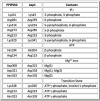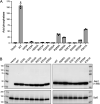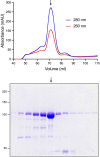Activities and Structure-Function Analysis of Fission Yeast Inositol Pyrophosphate (IPP) Kinase-Pyrophosphatase Asp1 and Its Impact on Regulation of pho1 Gene Expression
- PMID: 35536002
- PMCID: PMC9239264
- DOI: 10.1128/mbio.01034-22
Activities and Structure-Function Analysis of Fission Yeast Inositol Pyrophosphate (IPP) Kinase-Pyrophosphatase Asp1 and Its Impact on Regulation of pho1 Gene Expression
Abstract
Inositol pyrophosphates (IPPs) are signaling molecules that regulate cellular phosphate homeostasis in diverse eukaryal taxa. In fission yeast, mutations that increase 1,5-IP8 derepress the PHO regulon while mutations that ablate IP8 synthesis are PHO hyper-repressive. Fission yeast Asp1, the principal agent of 1,5-IP8 dynamics, is a bifunctional enzyme composed of an N-terminal IPP kinase domain and a C-terminal IPP pyrophosphatase domain. Here we conducted a biochemical characterization and mutational analysis of the autonomous Asp1 kinase domain (aa 1-385). Reaction of Asp1 kinase with IP6 and ATP resulted in both IP6 phosphorylation to 1-IP7 and hydrolysis of the ATP γ-phosphate, with near-equal partitioning between productive 1-IP7 synthesis and unproductive ATP hydrolysis under optimal kinase conditions. By contrast, reaction of Asp1 kinase with 5-IP7 is 22-fold faster than with IP6 and is strongly biased in favor of IP8 synthesis versus ATP hydrolysis. Alanine scanning identified essential constituents of the active site. We deployed the Ala mutants to show that derepression of pho1 expression correlated with Asp1's kinase activity. In the case of full-length Asp1, the activity of the C-terminal pyrophosphatase domain stifled net phosphorylation of the 1-position during reaction of Asp1 with ATP and either IP6 or 5-IP7. We report that inorganic phosphate is a concentration-dependent enabler of net IP8 synthesis by full-length Asp1 in vitro, by virtue of its antagonism of IP8 turnover. IMPORTANCE Expression of the fission yeast phosphate regulon is sensitive to the intracellular level of the inositol pyrophosphate (IPP) signaling molecule 1,5-IP8. IP8 dynamics are determined by Asp1, a bifunctional enzyme comprising N-terminal IPP 1-kinase and C-terminal IPP 1-pyrophosphatase domains that catalyze IP8 synthesis and catabolism, respectively. Here, we interrogated the activities and specificities of the Asp1 kinase domain and full length Asp1. We find that reaction of Asp1 kinase with 5-IP7 is 22-fold faster than with IP6 and is strongly biased in favor of IP8 synthesis versus the significant unproductive ATP hydrolysis seen during its reaction with IP6. We report that full-length Asp1 catalyzes futile cycles of 1-phosphate phosphorylation by its kinase component and 1-pyrophosphate hydrolysis by its pyrophosphatase component that result in unproductive net consumption of the ATP substrate. Net synthesis of 1,5-IP8 is enabled by physiological concentrations of inorganic phosphate that selectively antagonize IP8 turnover.
Keywords: Asp1; fission yeast; inositol polyphosphate kinase; inositol pyrophosphates.
Conflict of interest statement
The authors declare no conflict of interest.
Figures












Similar articles
-
Structures of Fission Yeast Inositol Pyrophosphate Kinase Asp1 in Ligand-Free, Substrate-Bound, and Product-Bound States.mBio. 2022 Dec 20;13(6):e0308722. doi: 10.1128/mbio.03087-22. Epub 2022 Dec 5. mBio. 2022. PMID: 36468882 Free PMC article.
-
Tandem inactivation of inositol pyrophosphatases Asp1, Siw14, and Aps1 illuminates functional redundancies in inositol pyrophosphate catabolism in fission yeast.mBio. 2025 May 14;16(5):e0038925. doi: 10.1128/mbio.00389-25. Epub 2025 Apr 16. mBio. 2025. PMID: 40237466 Free PMC article.
-
Genetic suppressor screen identifies Tgp1 (glycerophosphocholine transporter), Kcs1 (IP6 kinase), and Plc1 (phospholipase C) as determinants of inositol pyrophosphate toxicosis in fission yeast.mBio. 2024 Feb 14;15(2):e0306223. doi: 10.1128/mbio.03062-23. Epub 2023 Dec 22. mBio. 2024. PMID: 38133430 Free PMC article.
-
Inositol Pyrophosphates as Versatile Metabolic Messengers.Annu Rev Biochem. 2024 Aug;93(1):317-338. doi: 10.1146/annurev-biochem-030222-121901. Annu Rev Biochem. 2024. PMID: 39094034 Review.
-
Insights into the roles of inositol hexakisphosphate kinase 1 (IP6K1) in mammalian cellular processes.J Biol Chem. 2024 Apr;300(4):107116. doi: 10.1016/j.jbc.2024.107116. Epub 2024 Feb 24. J Biol Chem. 2024. PMID: 38403246 Free PMC article. Review.
Cited by
-
Activities and genetic interactions of fission yeast Aps1, a Nudix-type inositol pyrophosphatase and inorganic polyphosphatase.mBio. 2024 Aug 14;15(8):e0108424. doi: 10.1128/mbio.01084-24. Epub 2024 Jun 28. mBio. 2024. PMID: 38940614 Free PMC article.
-
One Scaffold, Two Conformations: The Ring-Flip of the Messenger InsP8 Occurs under Cytosolic Conditions.Biomolecules. 2023 Apr 4;13(4):645. doi: 10.3390/biom13040645. Biomolecules. 2023. PMID: 37189392 Free PMC article.
-
Structures of Fission Yeast Inositol Pyrophosphate Kinase Asp1 in Ligand-Free, Substrate-Bound, and Product-Bound States.mBio. 2022 Dec 20;13(6):e0308722. doi: 10.1128/mbio.03087-22. Epub 2022 Dec 5. mBio. 2022. PMID: 36468882 Free PMC article.
-
Tandem inactivation of inositol pyrophosphatases Asp1, Siw14, and Aps1 illuminates functional redundancies in inositol pyrophosphate catabolism in fission yeast.mBio. 2025 May 14;16(5):e0038925. doi: 10.1128/mbio.00389-25. Epub 2025 Apr 16. mBio. 2025. PMID: 40237466 Free PMC article.
-
Kcs1 and Vip1: The Key Enzymes behind Inositol Pyrophosphate Signaling in Saccharomyces cerevisiae.Biomolecules. 2024 Jan 26;14(2):152. doi: 10.3390/biom14020152. Biomolecules. 2024. PMID: 38397389 Free PMC article. Review.
References
-
- Zhu J, Lau K, Puschmann R, Harmel RK, Zhang Y, Pries V, Gaugler P, Broger L, Dutta AK, Jessen HJ, Schaaf G, Fernie AR, Hothorn LA, Fiedler D, Hothorn M. 2019. Two bifunctional inositol pyrophosphate kinases/phosphatases control plant phosphate homeostasis. Elife 8:e43582. doi:10.7554/eLife.43582. - DOI - PMC - PubMed
Publication types
MeSH terms
Substances
Grants and funding
LinkOut - more resources
Full Text Sources
Molecular Biology Databases
